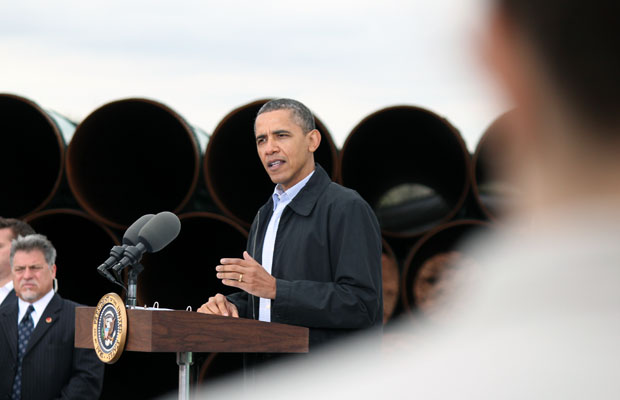
President Barack Obama speaking to supporters in a pipe yard in Cushing, Okla., where the Keystone XL Pipeline connects on its way from Canada to the Gulf Coast.
Joe Wertz / StateImpact Oklahoma


President Barack Obama speaking to supporters in a pipe yard in Cushing, Okla., where the Keystone XL Pipeline connects on its way from Canada to the Gulf Coast.
Joe Wertz / StateImpact Oklahoma

Joe Wertz / StateImpact Oklahoma
President Barack Obama speaking to supporters in a pipe yard in Cushing, Okla., where the Keystone XL Pipeline connects on its way from Canada to the Gulf Coast.
The Keystone XL Pipeline is a key part of Mitt Romney’s presidential campaign, which Oklahoma oil billionaire Harold Hamm is helping craft as chief energy adviser.
But only three years ago, Hamm — chairman and CEO of Oklahoma City-based Continental Resources — used to be “one of the most effective” opponents of the pipeline project, Reuters reports. The Oklahoma oilman stood alongside landowners and environmentalists, and formed a lobby group of Oklahoma oilmen that successfully squashed permits for the pipeline.
So what changed his mind?
It was money, David Sheppard, Joshua Schneyer and Alexander Cohen report.
At first, Hamm led efforts to keep the Keystone XL pipeline out of the Sooner State because he didn’t want Continental’s market flooded with cheap Canadian crude.
But Hamm convinced TransCanada to modify their plan by adding a $140 million pipeline extension that would carry Hamm’s crude on its way to refiners along Texas’ Gulf Coast.
Hamm’s resistance to Keystone ended in 2010, after TransCanada agreed to build a $140 million spur line to the isolated Bakken fields. That addition would take 100,000 barrels per day of U.S. crude starting in 2014. Continental signed a deal to ship 35,000 barrels a day on the line.
In another victory, Hamm says his lobby group received a written confirmation from TransCanada it would build the southern leg of the pipeline first, a step since approved by the Obama administration while the northern leg awaits permission. The southern leg should help drain a glut of crude in the Midwest and help Continental earn more on its oil.
The deal could net Continental an extra $20 per barrel, which could mean $200 million more a year for the company, according to Reuters’ analysis.
It’s just this kind political business savvy and “tactical acumen,” as Reuters puts it, that propelled Hamm, a sharecropper’s son, to become one of the richest people in America. (He’s No. 35, if you’re counting.)
Hamm is an atypical pick as an energy adviser, Reuters reports.
Past presidential candidates have rarely, if ever, relied so openly on an oil magnate to draw up their energy agenda.
And Hamm’s history — as shown above — isn’t always in line with Republicans:
Hamm has sometimes fallen out with Republican politicians in Oklahoma, Thompson said, over their backing of the interests of Big Oil firms, which clashed with smaller independent oil producers like Continental.
Hamm also has bucked Republican orthodoxies. The party tends to oppose trade restrictions and government efforts to regulate businesses and markets. Hamm once successfully lobbied for state-ordered production cuts to raise prices in Oklahoma’s natural gas fields – a step that helped send prices higher around the country. At other times he has sought import tariffs against foreign oil suppliers.
Last week, Hamm testified before the House Energy and Commerce Committee in Washington, D.C., where he vouched for the continuation of billions in tax breaks for oil and natural gas drilling. President Barack Obama supports ending the tax breaks.
The meeting, Reuters reports, was a glimpse of Hamm’s next battle: taxes.
These tax provisions, some decades old, allow independent oil firms to expense drilling projects up front instead of depreciating the assets over years, and to write down oil reserves in the ground by 15 percent a year.
Hamm says drillers need the breaks in part so that they aren’t afraid to risk billions on new prospects where first wells often fail.